First MR-BD Launched 50 Years Ago
By Wes Oleszewski
When asked what kind of fuels it took to get the United States
to the moon, few average folks can give the correct answer. Those
who are space-buffs or who actually are a part of the aerospace
industry can usually name off the propellants such as LOX, RP1, LH2
and assorted hypergolic fuels. Although they are correct, they
often leave out one critical fuel without which no human would ever
have set foot on the lunar surface. Often left out is the one fuel
that was required in the greatest quantity- that would be political
fuel.
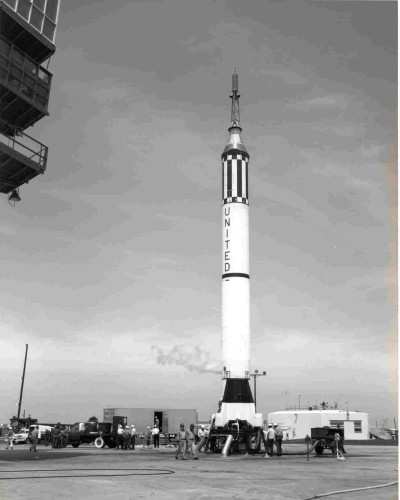
On March 24, 1961- exactly 50 years ago today (Thursday), an
event took place that through completely unintended consequences
would open wide the political fuel valves- it was the flight
monikered as "MR-BD." This was an event that is often overlooked,
and deliberately shunned by NASA itself because it caused the
dominoes of history to fall away from the favor of the United
States and into the direction of the Soviet Union. People working
on Project Mercury soon saw its affect as being their immediate
embarrassment in the press and in the eyes of the public. The
result of the MR-BD pointed to the USA as being second in the
"space race." Because the MR-BD mission was injected into the
flight schedule, Alan Shepard's flight was pushed back nearly two
months. That allowed the Soviets to place Yuri Gagarin into orbit
two weeks ahead of Shepard's flight and in the eyes of the world
"win" the glory of having put the first man into space. To many at
NASA, the MR-BD was seen as an unnecessary schedule slip that cost
them the prize of being first. In the hindsight of a historian,
however, MR-BD can be viewed very differently.
MR-BD was an acronym that stood for "Mercury Redstone- Booster
Development. It was extra flight that the von Braun team insisted
must be placed into the schedule of the Mercury Redstone test
flight series leading toward Alan Shepard's suborbital mission. In
the original schedule, Shepard's MR-3 mission was supposed to
launch in the third week of March. If the Soviets did not pull a
red rabbit out of their hat Shepard would become the first man in
space and thus "win" the space race for the United States. The
problem was that all three of the previous unmanned Mercury
Redstone launch attempts had run into a series of small problems
with serious, and in two cases, embarrassing consequences.
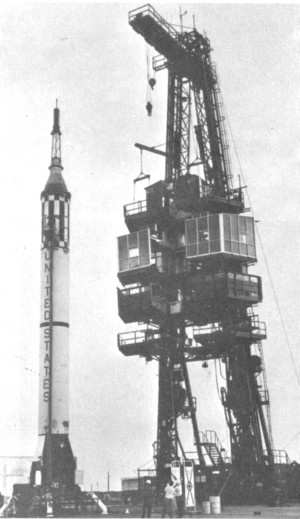
When the first Mercury Redstone, MR-1, attempted to launch it
had mismatch in the timing of two electrical plugs that pulled out
of the base of the booster at the instant of liftoff. As a result
it lifted about an inch, the engine was automatically shut down and
the escape tower alone was launched. MR-1A was the next attempt and
although it appeared to fly normally, later data analysis would
show a critical problem. The carbon vanes that jutted into the
exhaust flame to steer the Redstone showed an unexpected vibration.
The frequency and the magnitude of that vibration grew very near to
the predicted lifespan of the servo motors. Loss of one of them
could have easily resulted in the loss of vehicle control.
MR-2 was next and would carry Ham the chimp. At first the flight
looked normal, but for reasons that were, at the time, unapparent-
the booster was ascending too steeply and depleting its fuel at a
higher than normal rate. This was caused by the thrust controller's
servo control valve being stuck in the full open position. The
result was that the propellant fully depleted at exactly 137
seconds into the burn. That was 5.5 seconds before it was scheduled
and .5 seconds prior to where the integrating accelerometer was set
to arm. The ASIS (Abort Sensing Implementation System) sensed the
anomaly and commanded an abort- firing the escape tower and pulling
the Mercury spacecraft and Ham the chimp away from the booster. He
splashed down 137 miles farther downrange than planned and took
about 17 g's in the process. Although NASA officials later
displayed a healthy Ham as proof of a successful flight- the fact
was that this had been an abort, pure and simple. The flight was
actually, and properly aborted during boosted flight by the
triggering of the ASIS- the fact that the chimp had survived was
actually immaterial. Had Shepard or any other of the seven Mercury
astronauts been onboard that flight, the Soviets as well as the
American critics of the program (some of the most vocal of whom
were actually advising Kennedy) would have been quick to point out
that all NASA had done was boost the capsule to the point where the
mission was aborted by the automatic system designed to save the
astronaut's life.
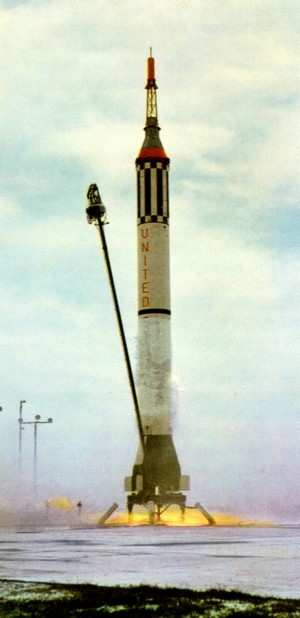
In the wake of the growing laundry list of little failures, the
von Braun team decided that another unmanned flight was required to
fix the problems. Members of the powerful STG (Space Task Group),
which was the original cartel of Langley engineers charged with the
foundations of NACA's and later NASA's manned space efforts, chose
to ignore the von Braun team's list of launch vehicle issues. The
STG deemed the problems to be minor. Thus the STG recommended to
NASA headquarters that Shepard's MR-3 mission should "go" according
to its original schedule and launch in March. Even decades later,
former members of the STG hold to their original position. In his
autobiography "Flight" former Mercury flight director Chris Kraft
states "The Germans were embarrassed by the Redstone's performance
on MR-2, and by their failure to predict its fuel flow." Of course
he ignores the fact that a stuck servo control valve nullified any
fuel flow predictions made by "…the Germans…" or
anyone else. One thing he does get right, however, is his statement
the STG gang was "furious" when von Braun insisted on another
test. Shepard himself recalled in his autobiography "Moon
shot" that the problem was a simple relay and nothing more.
In fact in their March 20, 1960 Memorandum addressing the
problems in the first three Mercury Redstones the STG itself cited
a total of nine different issues as presented by the von Braun team
at MSFC (Marshall Space Flight Center). They were: 1) Rudder and
carbon vane vibration, 2) Instrument compartment vibration, 3)
Thrust controller, 4) H202 tank pressure regulator, 5) Cutoff
arming time, 6) Roll abort sensor, 7) H202 system controller, 8)
Man-hole LOX leak, 9) Velocity integrator- it is easy to see that
the issue was a chain of malfunctions and clearly was not what
Shepard recalled as just one little relay that caused the flight of
MR-BD to be placed into the schedule. NASA Headquarters agreed;
MR-BD would fly in late March of 1961.
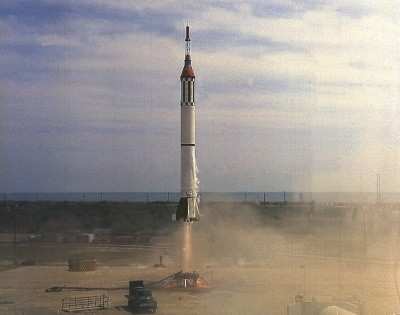
So put off was the STG over this decision that they refused to
allow the von Braun team to designate the flight as MR2-A or MR-3
and, again according to Kraft's book, they forced the "the Germans"
to use MR-BD as the moniker. Nearly a half century after the MR-BD
Kraft still refers to the MR-BD as being "…von Braun's
unnecessary Redstone test."
In aviation, or aerospace, the way that you prevent an accident
or a catastrophe is when you see a chain of circumstances or
failures that may lead to the accident, you break the chain. You
recognize the related issues as they add up and correct the
problems. In the case of MR-BD that is what the folks at MSFC did.
The flight of MR-BD went off smoothly as every one of the fixes
made by the von Braun team worked.
By delaying the schedule, the MR-BD inadvertently played
directly into the hands of the Soviets. On April 12, 1961 they
launched Gagarin's Vostok spacecraft and claimed the title of
having put the first man into space. They had the illusion that
this milestone would be a moral-buster for those people in the
west. The Soviets were badly mistaken, however. There is nothing
that Americans hate more than losing, and coming in second is
considered as just being the first one to lose. America's new
president, John F. Kennedy, had campaigned on the notion that the
United States was falling behind the Soviets in many areas-
especially spaceflight. It was an easy point to make considering
the indifferent posture that the Eisenhower administration had
taken toward manned spaceflight. Yet, the shockwave of the Vostok
mission's success that went through the American public now gave
Kennedy the perfect opportunity to fulfill his campaign
rhetoric.
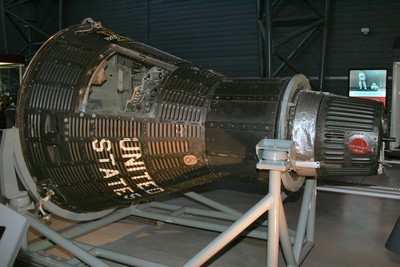
Across the United States the idea that "The Russians are beating
us" became ingrained in the public at large. In the Congress,
members heard from their home districts as the "What are you going
to do about it?" questions came from every corner. Kennedy now had
the political fuel needed not only to set the course of the United
States toward the moon, but to also gain the public inertia to
actually accomplish that goal over time. Had the STG, Chris Kraft,
Alan Shepard, et.al. gotten their way and had Shepard flown before
Gagarin, Americans would have thrown up their collective hands and
said "We Won!... the space race is over." And it may very well have
been as the political fuel to go beyond Project Mercury would have
quickly evaporated. Thus, MR-BD was a very key link in the chain of
events that led to United States astronauts actually getting to the
moon. It served to open the valve that allowed the political fuel
to flow and Vostok made the spark that ignited Kennedy and
propelled a nation.
 ANN's Daily Aero-Linx (04.15.24)
ANN's Daily Aero-Linx (04.15.24) Classic Aero-TV: 'No Other Options' -- The Israeli Air Force's Danny Shapira
Classic Aero-TV: 'No Other Options' -- The Israeli Air Force's Danny Shapira Aero-News: Quote of the Day (04.15.24)
Aero-News: Quote of the Day (04.15.24) Airborne 04.16.24: RV Update, Affordable Flying Expo, Diamond Lil
Airborne 04.16.24: RV Update, Affordable Flying Expo, Diamond Lil ANN's Daily Aero-Term (04.16.24): Chart Supplement US
ANN's Daily Aero-Term (04.16.24): Chart Supplement US







